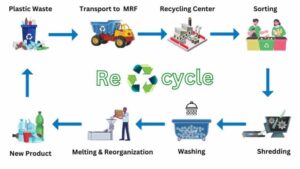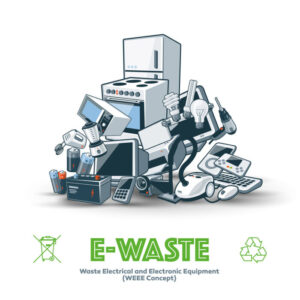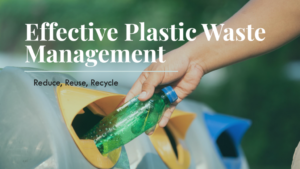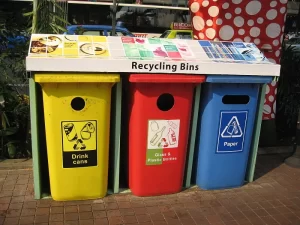LIFE OF TRASH
Waste items that are thrown away after they have fulfilled their intended purpose are referred to as trash. Food scraps, packaging, and broken goods are examples of this. Trash management is essential to maintaining a sustainable ecosystem since poor disposal can result in pollution, health risks, and the depletion of natural resources. Two important tactics to lessen the negative effects of rubbish on the environment are recycling and waste minimization. Knowing the entire waste lifecycle, from creation to disposal, might encourage more environmentally friendly habits in our daily lives.

A synthetic or artificial polymer that resembles the naturally occurring resins found in trees and other plants is called a plastic. Any of the several complex organic compounds known as polymers are created by the process of polymerization, which combines small molecules to form very big molecules that resemble chains. To create textile fibres, polymers can be moulded, extruded, cast into a variety of forms and films, or drawn into filaments. Today rather than handling the waste in the future should be adopted especially in Africa where there is high population growth.
Over time, the effects of the world’s rapid increase in plastic consumption have not received enough attention. As a result, mismanaged plastic garbage of a variety of kinds is now entering the environment in record quantities. Half of all plastic garbage produced worldwide is made up of packaging plastics. This essay aims to provide a general overview of the application, elimination, and control of plastics used in food packaging. Because of the growing global need for food brought on by population increase, there is an increasing demand for food packaging. The majority of food packaging is single-use plastic that is thrown away quickly and is utilized while traveling. The majority of this plastic garbage has entered the ecosystem, harming the land, water, and food web. Packaging material reduction, reuse, and recycling are advocated in the food sector. In order to achieve a circular economy, waste management must be approached holistically, involving all relevant parties. Adopting a strong pollution prevention strategy now is preferable to dealing with the garbage in the future, particularly in Africa where population expansion is rapid.
The swift advancement of technology has led to the rise of electronic garbage, also known as garbage Electronic and Electrical Equipment (WEEE), which poses a significant risk to human health and the environment through contamination. The primary cause of the world’s unregulated electronic waste is the rapid growth of innovation and low cost of production. As a result, enormous volumes of e-waste—whose disposal is a big concern—must be disposed of annually. E-waste management techniques like decreasing and recycling are essential to solving this issue. These methods aid in the development of a circular economy as well. This study focuses on the advantages of recycling while providing an overview of global e-waste generation data. It draws attention to the effects that e-waste has on both the environment and people. How green electronics might be a workable solution in this situation.
Plastic Waste
Waste plastic is the term used to describe thrown-away plastic items that are no longer needed or useful. This waste can originate from a number of things, such as consumer goods, packaging, manufacturing processes, and more. Its resilience and resistance to degradation provide serious environmental problems.

Sorting and Organizing Plastic Waste: Sorted By :-
- Primary Waste: Recently produced plastic bottles, straws, bags, and other products that are thrown away after one usage.
- Secondary Waste: Recyclable plastic items, such as used containers, that are gathered for recycling but have not yet undergone processing. Plastics that are gathered and processed to be recycled into new goods are known as tertiary waste.
Through Source :-
- Consumer Waste: Plastic containers and packaging that households discard.
- Industrial Waste: Comprises plastics produced during production processes, such as leftovers and faulty goods.
Commercial Waste
Plastics from establishments, like food service or retail packaging.
According to Degradation Potential :-
- Biodegradable Plastics: Usually composed of renewable resources, these are made to break down under certain circumstances.
- Non-biodegradable Plastics: Traditional plastics that linger in the environment for hundreds of years and do not decompose spontaneously.
In terms of Size :-
- Macroplastics are large plastic objects that are usually visible to the unaided eye, such as bottles and bags.
- Microplastics are microscopic plastic particles that are less than 5 mm in size. They are frequently produced as tiny pellets or as byproducts of the breakdown of bigger plastics.
According to Chemical Make-Up :-
- Thermoplastics: (e.g., PET, HDPE): Melt and reshape several times.
- Thermosetting Plastics: These include epoxy and phenolic, which harden permanently once moulded and cannot be remelted. It is essential to comprehend these classes in order to manage garbage effectively.
The word “e-waste” refers to a variety of electrical and electronic devices. If the owner doesn’t put it to better use, it’s trash, regardless of how old it is.
- Equipment for ICT and Telecommunications CPUs, displays, monitors, mouse, printers, keyboards, networking hardware, laptops, audio amplifiers, CDs, DVDs, and video cameras are all considered ICT items. And because it is the simplest to obtain, this number is maybe the highest in the modern period.
- Electronics for Office Use There seems to be an issue with office use and the quantity of rubbish in the planet. Calculators, photocopiers, electronic devices, typewriters, phones, fax machines, and facsimiles—if they are still used in the office—are examples of office electronics.
- Big appliances for the home, let’s start by identifying the large-sized electronics in your house. You could mention commonplace appliances like fans, air conditioners, refrigerators, cookers, radiators, and many more. Furthermore, it is categorized as electronic trash in a sizable dimensions.
- Tiny appliances for the home, if it was a big one, attempt to picture smaller things that are also a part of technological gadgets. These include swing weavers, fryers, hair dryers, and a host of other items. Additionally, there is a lot in this.
- Electronic Consumer Goods, the category of electronic trash will also include consumer goods. All activities that will be crucial to serving customers fall under this category for consumers. There are lots of activities in this category.
- Medical Supplies Furthermore, a lot of people are still unaware that this waste has a role in medical issues. The total amount of garbage can be computed by adding all of this together. Thus, electronic devices are used in the diagnosis, treatment, actions related to detection and prevention.
- Games, entertainment, and sports gear naturally, when children become older, there are games and toys they no longer play with. And some of those things have to be related to electronics. The toy is also categorized as e-waste if it has just one electrical part, like a battery. The security and environmental aspects of our homes are not the only difficulties we face. Today, the most prevalent problem is garbage, which is growing over time. Also, you notice a lot of different kinds of electrical garbage in circulation.
Life Cycles
Life cycle of plastics.
- Removal: Extraction of crude oil or methane gas is the initial stage in the production of a plastic product. These large-scale operations are primarily carried out by drilling and mining. Solid fossil fuels are extracted through mining by excavating, scraping, or in some other way revealing subterranean riches. Large amounts of extra rock and dirt are frequently poured into nearby valleys and streams as a result, which has an impact on the water flow and marine life.
- Refinement and cracking: After the extraction of fossil fuels, the raw materials are transported to a refinery. Refinement aims to extract propane from natural gas and ethane from crude oil, which are the raw materials needed to make plastic. Ethane and propane are subsequently chemically converted to ethylene and propylene at a cracking facility.
- Manufacturing and Processing: Resins are created by catalysing the polymerization of ethylene and polyethylene through chemical modification. The main component needed to make the robust, flexible plastics on which we have all become dependent is resin. This chemical procedure can be carried out in various different ways, leading to a range of plastic products. That’s what the numbers on the underside of a lot of plastic objects mean!
- To create “nurdles,” which are plastic pellets used in pre-production, resins are heated to high temperatures and pressures and then cooled. Manufacturers employ these plastic nurdles as an input to shape and make the plastic goods that we use.
- In addition, extraction sites are frequently left with degraded soil and damaged land that makes the surrounding people more vulnerable to hazardous water contamination, mudslides, landslides, and flash floods.
Life Cycle of Electronic Wastes
The Sector of Formal Recycling: Pursuing Sustainability The professional e-waste recycling industry in India, in  contrast to the unofficial sector, strives to handle electronic debris in an environmentally sound manner while abiding by legal and regulatory requirements. New technologies are being developed to enhance the sustainability and efficiency of processing e-waste, hence contributing to the continual evolution of the formal recycling sector. These developments—which range from sophisticated material recovery procedures to automated disassembly systems—are essential to solving the expanding e-waste problem. The idea of Extended Producer Responsibility is central to India’s e-waste rules (EPR). According to this idea, producers are in charge of a product’s whole lifecycle, including recycling and takeback at the end of its useful life. The time when people actively utilize electronic devices is known as the consuming phase. Although customer behaviours and attitudes throughout this phase have a significant impact on the device’s lifespan and eventual fate, they do not directly contribute to e-waste.
contrast to the unofficial sector, strives to handle electronic debris in an environmentally sound manner while abiding by legal and regulatory requirements. New technologies are being developed to enhance the sustainability and efficiency of processing e-waste, hence contributing to the continual evolution of the formal recycling sector. These developments—which range from sophisticated material recovery procedures to automated disassembly systems—are essential to solving the expanding e-waste problem. The idea of Extended Producer Responsibility is central to India’s e-waste rules (EPR). According to this idea, producers are in charge of a product’s whole lifecycle, including recycling and takeback at the end of its useful life. The time when people actively utilize electronic devices is known as the consuming phase. Although customer behaviours and attitudes throughout this phase have a significant impact on the device’s lifespan and eventual fate, they do not directly contribute to e-waste.
Framework for Law and Regulation
- In India, laws, rules, and policies pertaining to the management of electronic waste are designed to ensure that the garbage is handled in an environmentally responsible manner.
- E-waste has a lifespan that starts long before a device runs out of useful life. It begins at the production phase, when the choices created through producers have a significant influence on how the products will ultimately affect the environment.
- End-of-Life: The Shift to Electronic Waste Electronics go into the critical stage of potentially becoming e-waste when their useful lives are nearing to an end. The current handling of these gadgets has important social and environmental ramifications.
MANAGEMENT OF WASTES

PLASTIC WASTE
Unchecked use of plastics for transportation, industry, agriculture, and packaging in both urban and rural settings has highlighted the serious issue of managing plastic trash and its contamination. There are advantages and disadvantages to each of the three most common disposal strategies for plastic: landfilling, incineration, and recycling.
Landfill: Any place where we dispose of disposable plastic debris after it has been used and before it is buried beneath the Earth’s surface is referred to as a “landfill.” The landfill arrangement’s goal is to protect the environment in all its forms by offering a safer location for the disposal of plastic trash. To achieve the previously specified objectives. The community must put up a lot of work to fill it with rubbish, which includes excavating a deep hole or dumping in it and letting it break down.
Amendment Rules for Plastic Waste Management 2022: Extended Producer Responsibility Certificates: Extra certificates of extended producer responsibility may be bought and sold in accordance with the criteria. By doing this, a commercial mechanism for the disposal of plastic garbage will be established. responsibility
The annual reporting of State Pollution Control Boards (SPCBs) to the CPCB regarding the compliance of manufacturers, importers, brand owners, and processors of plastic waste in the state and union territory with the EPR is their responsibility.
Recycling: Recycling offers the chance to design a new product with recycled plastics. When it comes to reducing the impact of post-consumer plastic packaging trash at the end of its useful life, recycling is thought to be the best choice in the solid waste administration hierarchy.

Incineration: Incinerating plastic garbage is another common way to manage it. In terms of recovering energy in the form of heat, burning plastic is a convenient and space-efficient method.
Regulations for managing plastic garbage from 2016: Incorporating a system for producers and brand owners to collect back plastic waste by extending producers’ obligation, as well as adding the responsibilities of producers and generators to the system for managing plastic waste.
To create a pre-registration system for manufacturers, importers, and retailers of plastic carry bags and multilayered packaging in order to collect fees for managing plastic trash.
HANDLING & DISCHARGE
- Dumping
- Excitement
- Pyrolysis
- Recycle and reuse
EXISTING INDIA WASTE MANAGEMENT PRACTICES
- Plastic Waste: Items like casings, front panels, and rear panels are composed of plastic. Various components covered in plastics. The melting and shredding of management practices. Printed circuit board trash is utilized in certain electrical parts and fire inhibitors. Desoldering and open burning are management practices used to eliminate metals. Chips, electronic wires, shattered glass, and waste containing copper are examples of miscellaneous waste. Chemical stripping, open burning, and mixing part of the waste with municipal solid garbage are the management techniques used.
- Liquid Waste: This includes general waste, acid stripping waste, and interior chemicals.
E-WASTE
There are three main phases of E-waste recycling.
- Sorting: In order to separate particular components, including batteries and lightbulbs, for further processing, the initial stage in the processing of e-waste is manual sorting. Some things might need to be manually disassembled at this point in order to salvage useful parts or resources for later use.
- Disassembly/Dismantling: Disassembly refers to the methodical removal of parts, components, a subassembly, or a set of parts from a product (also known as partial disassembly), or the total disassembly of a product for a specific purpose. Isolating valuable or hazardous materials typically calls for this.
- Upgrading: Metals including copper, aluminium, and gold as well as non-metals can be found in e waste Typically, upgrading consists of two stages: material separation and comminution employing metallurgical, physical, and/or mechanical processing to get the materials ready for refining procedures. Precious metal-oriented recovery techniques, such as hydrometallurgy and pyrometallurgy, are becoming less common whereas mechanical/ physical separations of e waste which are easier.
References
https://www.elxion.in/blogs/the-lifecycle-of-e-waste-in-india-fromproduction-to-disposal
https://waste4change.com/blog/types-of-electronic-waste-definitionand-categories/
https://debrisfreeoceans.org/the-life-cycle-of-plastics/
https://www.google.com/url?q=https://www.chemicalsafetyfacts.org/c hemistry-101/an-introduction-to-
plastics/&usg=AOvVaw1CIwJMQE8oi0Glt7GD5i_H&hl=en-IN
https://www.slideshare.net/_shivam_/e-waste-its-management
Ms. Isha Rawat & Ms. Sejal Rana
Pestle Weed Nature Preservation Society



